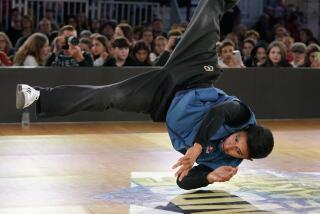It May Be Flighty, But This Sport Is Truly a Guy Thing
- Share via
PRAGELATO, Italy — Watching ski jumper after ski jumper take flight Saturday, all I could think of was insurance.
First off, I hope they all have life insurance. And it also reminds me why young men have to pay extra for car insurance: Because although women might act like they’re crazy, men like to do crazy things.
Ski jumping -- in its pure form and paired with cross-country skiing in the Nordic combined -- is the only Winter Olympic event in which women do not compete. There just aren’t that many at the top level. Maybe it’s because they have the good sense not to zoom down a ramp up to 70 mph, fly the length of a football field without wings, then land and come to a stop without brakes.
“Other than sky diving, I can’t think of anything that would come close,” said American Jim Denney, whose father was a ski jumper in the 1976 and 1980 Olympics.
Ski jumping isn’t just a male thing. It’s an oddball male thing. You have to be a little bit different to get into this sport, which explains why among the competitors gathered at these Games you’ll find a Slovenian who owns a two-foot boa constrictor (Rok Benkovic), an Italian who kept his ski-jumping activities a secret from his parents until they read about it in the newspaper (Alessio Bolognani) and an Austrian soldier whose motto is “Only dead fish swim with the current” (Martin Koch).
Some of the best entries in David Wallechinsky’s “Complete Book of the Winter Olympics” come from ski jumping.
It’s the sport that gave us “Eddie the Eagle” Edwards. He called himself Eddie the Eagle even though his awkward style didn’t remind anyone of a bird in flight, and even though his first name was Michael.
It’s the sport in which Heiko Hunger of Germany withdrew in the middle of competition in 1992 because, he said, “My horoscope said I shouldn’t take any risks.”
And, sadly, it’s the sport that gave us the story of Finland’s Matti Nykanen, the worst fall from grace of any Olympic star. Nykanen was the dominant figure in his sport. He blew out the competition in Sarajevo in 1984 by the widest margin in Olympic history and he won three gold medals in Calgary four years later.
The rest of his life was a series of failed marriages and blown money. It got so bad he sold his medals and turned to stripping. And in 2004 he was found guilty of aggravated assault for stabbing a man in the back. He was released last September but arrested four days later and charged with abusing his girlfriend. Now you know why his autobiography is titled “Greetings From Hell.”
“He was a really great ski jumper,” said Janne Happonen, a Finnish jumper in this year’s Olympics. “I don’t know what to say.”
Despite the varying degrees of oddity, there’s one thing all of these guys have in common: toughness.
Finland’s Janne Ahonen keeps jumping even though he has broken his collarbone, his left leg and both forearms. Even the guy nicknamed Harry Potter because he looks like the young wizard is tough. Simon Ammann of Sweden had a nasty fall during his first jump on qualification on the normal (or smaller) hill on Saturday and injured his knee. He twisted, tumbled and crashed into the barrier on the left side of the landing area. He was placed on a stretcher and hauled off by a snowmobile. But he was back for his next jump an hour and a half later.
The bravest of them all might not even be the competitors. Each site has “forerunners” whose job is to test the usability of the site. Sometimes when the weather gets dicey, they’ll send the forerunners down first to see the usability of the venue. Their reward for putting their lives on the line: room and board, plus 15 euros a day.
If you’re eager for baseball to start, here’s some talk of steroids and doctored equipment to hold you over.
Hans-Georg Aschenbach of Germany, the gold-medal winner in 1976, later admitted to using steroids for eight years before the Montreal Games.
And Saturday, two of the four people disqualified for illegal equipment were the best jumper of the day and the best story of the event.
Lars Bystoel of Norway jumped 104.5 meters, but was disqualified because his suit did not meet regulations to maintain even aerodynamics. Masahiko Harada of Japan was cut loose for using skis that were too long for his weight. Harada is one of Japan’s most revered Winter Olympians for the way he bounced back from disappointment in 1994 to win a team gold in Nagano at the next Olympics.
Because of his status, Harada Kwanned his way onto the 2006 team even though he has not competed on the World Cup circuit since 2002. Then he was busted after his second jump.
“I was only 200 grams lighter than I should have been,” Harada said. “Of course it was all my fault.”
Busts, apologies, injuries, courage. And, of course, there’s a chance for an agony-of-defeat moment every time a skier heads down the ramp.
*
J.A. Adande can be reached at j.a.adande@latimes.com. To read more by Adande go to latimes.com/adandeblog.
More to Read
Go beyond the scoreboard
Get the latest on L.A.'s teams in the daily Sports Report newsletter.
You may occasionally receive promotional content from the Los Angeles Times.






